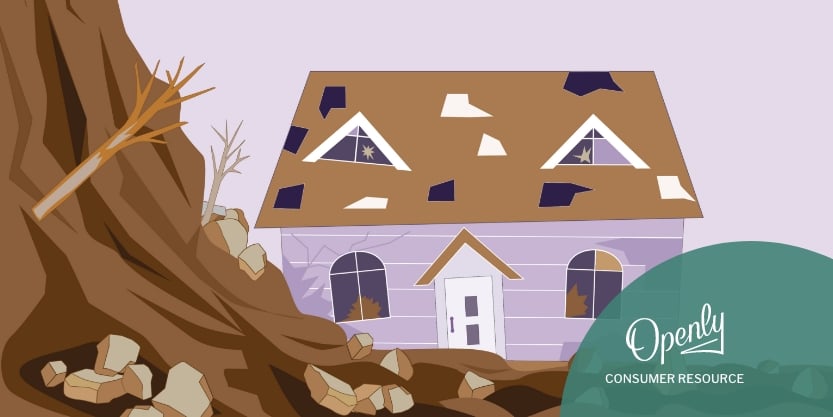When it comes to protecting your home, homeowners insurance is an important investment. It shields you from many risks, but what about landslides?
Natural disasters can strike at any moment, and as a homeowner, it's important to know what types of events are covered by your homeowners insurance policy.
In this article, we’ll explore whether or not landslides are covered by home insurance and what factors may affect coverage.
At a glance:
- Understanding the insurance definitions for landslides, floods, and earthquakes is critical, as each event's coverage varies and are typically excluded from standard policies, requiring separate policies or endorsements.
- Factors like your home's location, homeowners insurance policy type, and cost influence whether landslide coverage is affordable, or even available.
- Homeowners in landslide-prone zones should consider additional coverage, as standard policies may not provide sufficient protection against landslide damage.
What is a landslide?
Insurance providers distinguish landslides from other events like floods or earthquakes. As all three of these natural disasters are typically excluded from standard policies, it’s important to understand the insurance definition of a landslide to ensure you can seek out adequate supplemental coverage.
Landslides, in the context of insurance, refer to the movement of rock, earth, or debris down a slope. This can be caused by various factors such as heavy rainfall, earthquakes, or human activities like construction.
Floods or earthquakes
Landslides may be linked to floods or earthquakes, which usually are not covered under standard homeowners insurance. Flood insurance typically handles damage from water-related events, while earthquake insurance covers damage caused by seismic activities.
Is landslide insurance included in home insurance?
Unfortunately, most standard home insurance policies do not cover landslides.1 This is because landslides are considered a ground or earth movement, which is typically excluded from coverage. However, most homeowners policies may cover an ensuing fire, explosion, or theft resulting from earth movement. Some policies may even offer coverage for landslides as an endorsement. It's important to review your policy carefully to see if it includes landslide coverage.
Coverage related to landslides
While homeowners insurance covers a range of perils, landslides and other natural disasters often have distinct considerations. As homeowners, it's crucial to be informed about the limitations of your homeowners policy, especially when residing in areas prone to geological events.
Factors that affect landslide coverage
There are a few factors that may affect whether or not your home insurance policy covers landslides, including location, policy type, and cost.
Location
The location of your home plays a significant role in determining the availability of landslide insurance coverage. If you live in an area that is prone to landslides, such as a mountainous region, your insurance company may not offer coverage for landslides due to the higher risk.
Policy coverage
As mentioned earlier, some home insurance policies offer landslide coverage as an add-on. If you live in an area prone to landslides, it may be worth considering purchasing a home insurance policy that includes this coverage.
Cost
The cost of landslide insurance can vary depending on the location of your home, the type of policy, and the level of coverage. In areas where landslides are more common, the cost of insurance will likely be higher. It's important to shop around and compare quotes from different insurance companies to find the best coverage at the most affordable price.
Assessing your home's vulnerability
Identifying areas prone to landslides and understanding how your home's location impacts coverage is vital for proactive risk management.
Areas prone to landslides
Homes situated on steep slopes or in regions with a history of landslides are more susceptible to landslides. It's important that homeowners assess the geological characteristics of their property and surrounding areas for better decision-making regarding insurance coverage.
Optional coverage for landslides
Given the limitations of standard coverage, homeowners in high-risk zones should consider additional coverage options tailored to landslides. Exploring these choices can help you find a policy that provides an extra layer of protection against the financial repercussions of landslide damage.
Additional coverage
While standard homeowners insurance offers crucial protection, it may not be sufficient in areas prone to landslides. Homeowners should recognize the need for additional coverage to safeguard their investment adequately.
High-risk zones
There may be insurance providers that offer specific policies or endorsements for landslide coverage. Homeowners should consult with their insurance agent to explore these options and choose the most suitable coverage for their unique circumstances.
Filing a claim for landslide damage
If you do experience landslide damage, and you proactively added a landslide endorsement to your coverage or secured a standalone landslide policy, it's important to know what is needed for a successful claim. Understanding the documentation requirements and following the correct steps will facilitate a smoother claims process.
How to file a claim
Here's a detailed breakdown of how to file a home insurance claim after a landslide:
- Contact your insurance provider promptly to initiate the claims process.
- Take photographs of the landslide damage and any affected personal property.
- Submit all required documentation, including estimates for repair or replacement costs.
- Your insurance provider may send an adjuster to assess the damage. Their assessment will help determine the coverage and settlement amount.
Mitigating financial vulnerability
Landslides are unpredictable natural disasters that can cause severe damage, but with the right knowledge and insurance coverage, they can be mitigated. Assessing your home's vulnerability, taking proactive measures to protect your property, and exploring optional coverage are essential steps in mitigating the financial risks associated with landslides. These steps can help you fortify your defenses against the unexpected forces of nature.
* We provide this information to help you understand insurance. Any coverage is subject to the terms of your policy. Please refer to your policy and declarations page for complete terms, conditions and coverage details.
1 Insurance Information Institute “Insurance for landslides and mudflow.” III.org, Accessed 15 March 2024. https://www.iii.org/article/insurance-for-landslides-and-mudflow#:~:text=A%20landslide%20is%20considered%20an,%2C%20earthquakes%2C%20and%20floods)




